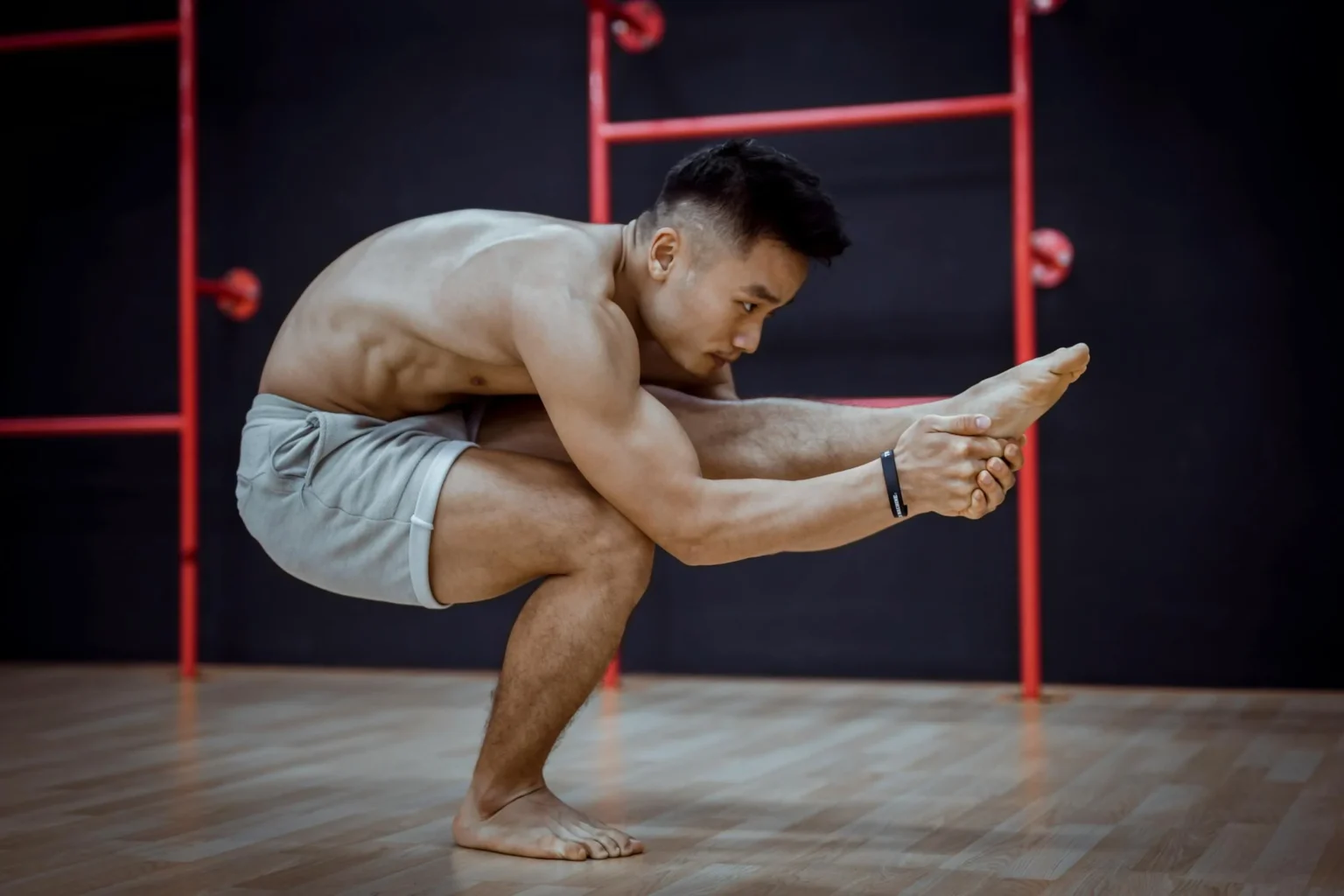Ever look at those super-bendy Instagram yogis and think, nah, my body can’t do that? Think again—these seven yoga poses will help you lengthen your body and feel more limber.
Yes, You Can Be More Flexible!
Always wanted to do wheel pose with ease? Frustrated that forward bends are so difficult and don’t know why? (Hint: Every forward bend is a back bend in disguise!) Improving back flexibility is the most often requested routine I get—whether it’s in a class, a private session, through Facebook, though Instagram, or through my website. Everyone seems to want a more flexible back. This is a really good thing, because a more flexible spine reduces overall back pain, helps you sleep (because of previously mentioned reduced back pain!), and improves your posture.
What you may not consciously realize is that everything in your body is connected. So when one part of your body is tight or constricted, it has a domino effect on the rest of your body. Often, in order to improve back flexibility, we need to make space on either side of the spine—most notably, in the hips and the shoulders.
These seven yoga poses will help you open your hips, open your shoulders, create more space in your body, and improve your overall back flexibility. I recommend doing all seven of these yoga poses at least three times a week, finishing with your favorite spinal twist when you are done. Take lots of deep breaths, and relax. Flexibility starts in the mind. If you believe you can, you will. If you believe you are flexible, you will be.
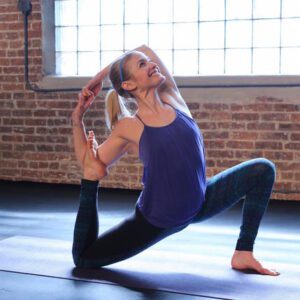
Cat/Cow
Come to all fours with hands under shoulders and knees under hips. Inhale and look up with an arched spine, rolling shoulders away from ears for cow. As you exhale, press the floor away with hands and knees, and round your spine, like an angry cat. Do at least five complete breath cycles (five inhales/cats and five exhales/cows).
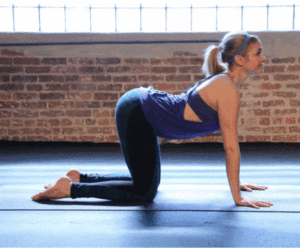

Sphinx Pose
Lie on your stomach, place elbows underneath shoulders, forearms on the ground, and pull chest forward as you press shoulders down and together while lengthening through your tailbone. Make sure all 10 toes are on the ground. Stay for five deep breaths, breathing length between each vertebra from tailbone to the crown of your head.


“Easy” King Pigeon Pose
Begin in a long low lunge with your right foot forward, and tap your back knee down. Slowly crawl your hands up onto your right thigh and breathe here for five deep breaths. Bend your left knee, grab hold of the left foot and place it in the crook of your left elbow, then try to square off your hips. Bend your right elbow and reach your right hand back to clasp your left. If you can’t reach, use a hand towel or yoga strap in between your hands. Stay here for at least five deep breaths, then repeat on the left side.


One-Legged King Pigeon Pose
From down dog, sweep your right shin forward, toward the front of the mat, but not as parallel to the front of the mat as you would in a forward-bending pigeon. Keep your left leg long behind you, toes untucked. Bend your left knee and take a hold of the left foot and place your foot in the crook of your left elbow. Reach your right arm to the ceiling, bend your right elbow, and reach your right hand back to clasp your left. Breathe here.
Next, take a strap, loop it around your back foot with enough slack to face your torso forward, bringing your upper arms on either side of your head with your forearms parallel to the ceiling and hands holding the strap. Slowly, start to crawl your hands as close to your back foot as they want to get. Stay here, or when possible, take a hold of the back foot with both hands and release the strap. Breathe here at least five deep breaths, come out of the pose very slowly. Repeat on the other side.
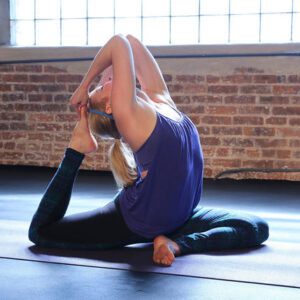

Half Frog Pose
Begin lying facedown on your mat. Rise onto your forearms with your elbows directly underneath your shoulders and breathe here in sphinx pose. Keeping your knees no wider than hip-width apart, bend your left knee and bring your left hand to the top of your left foot, fingers facing the same direction as the toes. Your elbow grazes your rib cage; don’t let it wing out. Lift through your chest. Breathe here for at least three deep breaths, and then repeat on the other side. If you are very comfortable with this variation, you can deepen the pose by lengthening the bottom arm (as pictured).
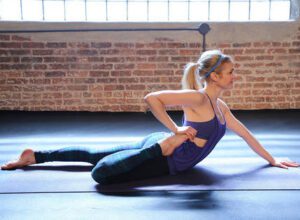

Bow Pose
Lie facedown, bend knees, and grab ankles with hands. Press your feet away from your head, ankles into your hands, keeping knees hip-width apart, and lift chest off the ground. Stay here for at least five deep breaths. Try grabbing both the inside and outside of your ankles for a different shoulder opening.
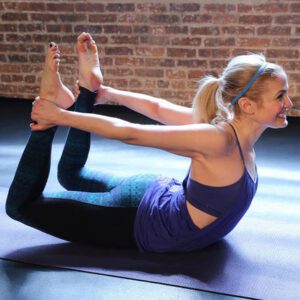

Supported Bridge with Hip Opener
Begin lying on your back. Bend your knees, placing feet on the ground hip-width apart. Lift your hips and place a block underneath you at whatever setting feels best for your back, then lower sacrum onto the block. Release your arms to either side of your body and, once you feel steady, place the bottoms of your feet together, allow your knees to fall apart, and breathe here for at least 10 deep breaths.
To release, place your feet back on the ground hip-width apart, come on to balls of your feet, lift your hips, remove the block off the side, and gently release back onto the ground. Start this pose at the lowest height of the block and gradually work your way up to the block’s highest height, if that feels OK for your back on any given day.
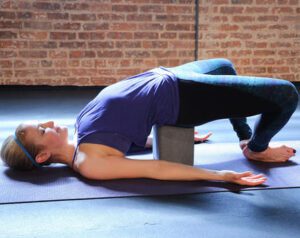

Final result
Flexibility and freedom of movement are important aspects of physical health. However, stress, aging, lack of exercise, and poor posture can cause your muscles to become tense and tense, limiting your flexibility.
Regular yoga poses is a very effective way to relieve muscle tension and increase flexibility. The key is to start slowly and gradually increase the amount of time you can maintain proper form.


